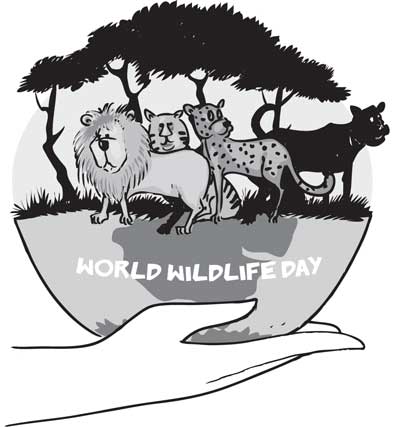Reply To:
Name - Reply Comment
Today is an important day for Sri Lanka and the world – it is world Wildlife Day with the 2018 theme being “Big Cats: Predators under threat”. According to the United Nations, on December 20, 2013, at its 68th session, the UN General Assembly proclaimed March 03 - the day of signature of the Convention on International Trade in Endangered Species of Wild Fauna and Flora (CITES) - as UN World Wildlife Day. The aim was to celebrate and raise awareness of the world’s wild animals and plants.

The UNGA resolution also designated the CITES Secretariat as the facilitator for the global observance of this special day for wildlife on the UN calendar. World Wildlife Day has now become the most important global annual event dedicated to wildlife.
The UN, underlining the incalculable value of wildlife, says the animals and plants that grow in the wild have an intrinsic value and contribute to the ecological, genetic, social, economic, scientific, educational, cultural, recreational and aesthetic aspects of human well-being and sustainable development.
World Wildlife Day is an opportunity to celebrate the many beautiful and varied forms of wild fauna and flora and to raise awareness of the multitude of benefits that conservation provides to people.
According to the UN, at the same time, the Day reminds us of the urgent need to step up the fight against wildlife crime and human induced reduction of species. This has a wide-ranging economic, environmental and social impact. Given these various negative effects, Sustainable Development Goal #15 focuses on halting biodiversity loss.
Big cats are among the most widely recognized and admired animals across the globe. However, today these charismatic predators are facing many and varied threats, which are mostly caused by human activities. Overall, their numbers are declining at a disturbing rate due to loss of habitat and prey, conflicts with people, poaching and illegal trade.
For example, tiger populations plummeted by 95% over the past 100 years and African lion populations dropped by 40% in just 20 years. But a range of measures are underway to arrest this decline, the UN says. In an effort to reach as wide an audience as possible, the expanded definition of big cats is being used. They include not only lion, tiger, leopard and jaguar -- the 4 largest wild cats that can roar - but also cheetah, snow leopard, puma and the clouded leopard. Big cat species are found in Africa, Asia, and North, Central and South America, representing a virtually global distribution.
UN Secretary General António Guterres, in a message to mark world Wildlife Day has called on the people to help raise awareness and to take personal action to help ensure the survival of the world’s big cats and all its precious and fragile biological diversity.
In Sri Lanka, the majestic Elephant – once acclaimed as the king of our jungles, is today facing various dangers such as the human-elephant conflict, largely because a selfish society is robbing the jungle homelands of the elephants. So when elephants come out in search of food we call them rogues.
We need to be aware that conservation is important because the Earth’s living resources are valuable. Natural ecosystems, for example, help maintain supplies of fresh water, and protect people from floods, land-slides, soil erosion, siltation and the effects of climate change. Wild species depend on such ecosystems and can be used as important sources of foods, medicines and other subsistence and trade goods, while providing opportunities for recreation, tourism, science and education. Genetic resources are contained within wild species and can be used to improve crop plants and livestock breeds, for instance by making them resistant to pests and diseases. For these reasons, a comprehensive and effective approach to the sustainable management of protected areas and wildlife resources is needed.